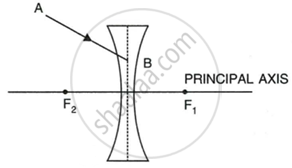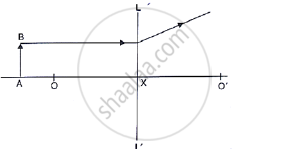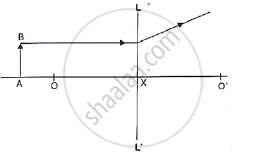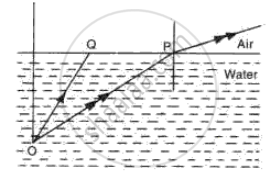Advertisements
Advertisements
प्रश्न
State the condition of the following:
A ray passes undeviated through the lens.
उत्तर
A ray of light passing through the optical centre of the lens passes undeviated.
APPEARS IN
संबंधित प्रश्न
In figure, (a) and (b), F1 and F2 are the two foci of thin lenses and AB is the incident ray. Complete the diagram to show the path of the ray AB after refraction through each lens.
 |
| (a) |
 |
| (b) |
Study the diagram shown in Fig. 5.56
Complete the diagram to show the formation of image A’B’ of the object AB of same size.

Study the diagram shown in Fig. 5.56
what are the two other characteristics of the image?

The diagram given below shows the position of an object OA in relation to a converging lens whose foci are at F1 and F2.

Describe three characteristic of the image.
Fig. shows two rays of light Op and OQ coming from an object at the bottom of a pond, incident on the water surface.

(a) Mark on the diagram
(i) The angle of incidence of ray OP,
(ii) The angle of refraction of ray Op,
(iii) The position of image of the object as seen from above.
(iv) An approximate path of the ray OQ.
(b) Explain, why do the rays of light change directions on passing from water to air.
(c) A fish in water sees everything outside the water by rays of light entering its eye in a small cone of light. Draw a diagram and explain how does this happen.
How will you differentiate between a convex and a concave lens by looking at a printed page?
Complete the following diagram and state what happens to the ray of light after refraction through the lens.

Complete the following diagram and state what happens to the ray of light after refraction through the lens.

